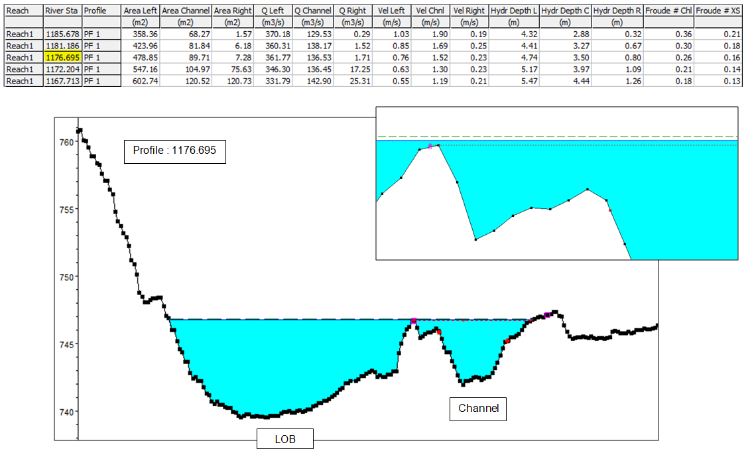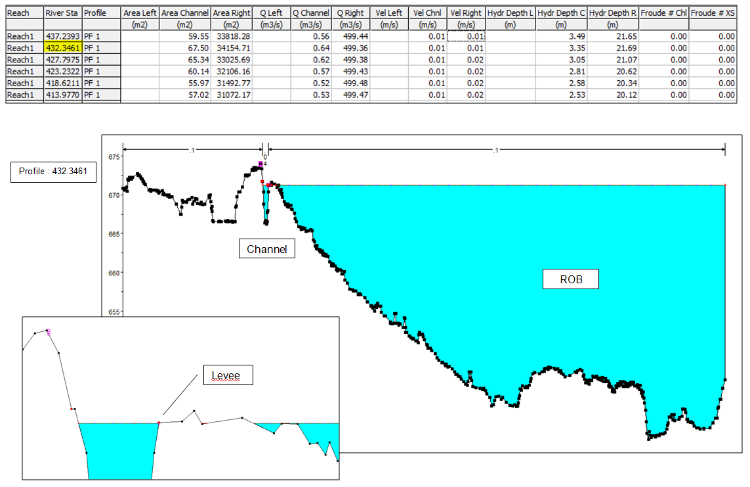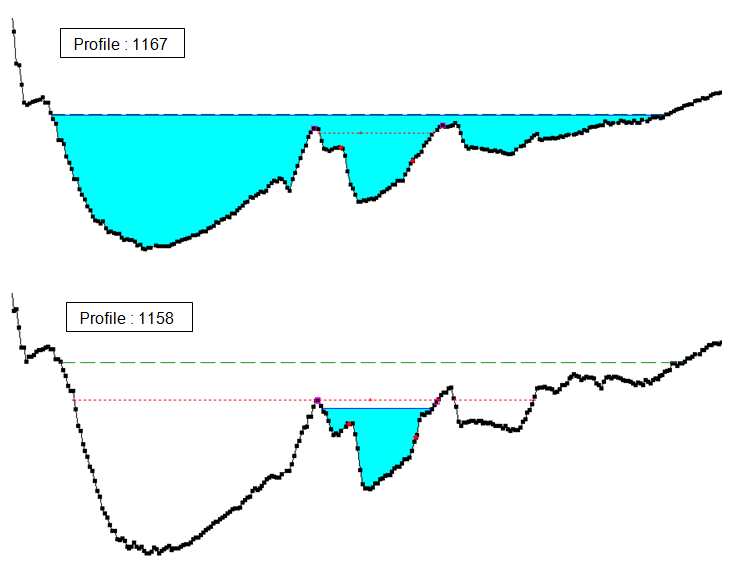Welcome to the RAS Solution › Forums › HEC-RAS Help › 1D model: Overflow from high ground channel to low ground major bed
- This topic has 0 replies, 180 voices, and was last updated 6 years, 2 months ago by Zoran.
-
AuthorPosts
-
September 26, 2019 at 1:32 pm #7456ZoranParticipant
I am creating a 1D model (steady state) to study the overflow of a river whose channel bottom is at an altitude higher than the major bed (LOB and ROB).
When I analyse the results of the model I observe 3 characteristic profiles:
Profile 1: The flow is supercritical (Fr > 1), the water velocities are fast and the entire flow is conveyed by the channel (500 m3/s).
Profile 2: The flow is subcritical (0 > Fr > 1), the level of water increases which causes water to overflow into the overbanks. In this case, most of the flow is conveyed by the major bed (360 m3/s) and the remainder is conveyed by the channel (140 m3/s). Flow discharges are low in both regions (channel and OB), but remain higher in the minor bed than in the channel. The water level is higher than the critical water level.
Profile 3: Similar to situation 2, except that in this case almost the entire flow is conveyed by the major bed (499 m3/s). Flow velocities are very low and equal in the minor bed and the major bed (0.01 m/s). The water surface elevation in the major bed is very important (20 m). The Froude number is zero. In this case, the water height is equal to the critical water level.
Here my interpretations of the previous results (according to my knowledge of 1D models that is quite limited):
1. When the flow is supercritical, the velocity of the water is high and the water surface is low. All the water is conveyed by the channel and there is no overflow.
2 and 3. When the water reaches the top of the banks and the overflow occurs, HEC RAS automatically fills with water every surface in the LOB and ROB that is at an altitude lower than the water level. If the channel is above the major bed, the filling area can be very large. The wet perimeter increases very strongly, as does the height of water in the major bed. At that point, the software recalculates the hydraulic tables taking into account the new flow surface and the new water heights, while ensuring that the total flow transported by the section remains the same as in the previous sections (500 m3/s) . The consequence is that the flow velocities become very low, so does the Froude number (Fr = v/(D*g)^0.5).
In view of the above, here are the questions I ask myself:
1. If we compare situation 2 to 3, why in the first the flow velocity in the channel is greater than the the one in the LOB? In this case, it seems that the conveyance is well differentiated between the channel and the major bed and that a significant part of the water transits through the channel. In situation 3, on the other hand, almost all of the flow is in the major bed and the velocities are the same in both regions.
2. Why does the water level in situation 2 exceed the critical water level when it is equal to the water level in situation 3? Does this mean that the software has not converged to a solution (“default to critical depth”)?
3. What is the best way to model this type of overflow in HEC RAS? Is there a way to have the water overflow gradually so that the water flows from the top of the levee to the bottom (by gradually filling the “holes” in the terrain). Most of the water should remain in the channel and only a part of it should overflow.
4. What happens with the water that has overflowed the channel at the downstream profile? I have the impression that all the water is reinjected into the minor bed in the next profile and that if the flow becomes supercritical it is able to carry all the water (situation 1) so that the water disappears from the major bed. This leads to a successions of profiles where water is present in the major bed followed by dry major beds…
-
AuthorPosts
- You must be logged in to reply to this topic.



